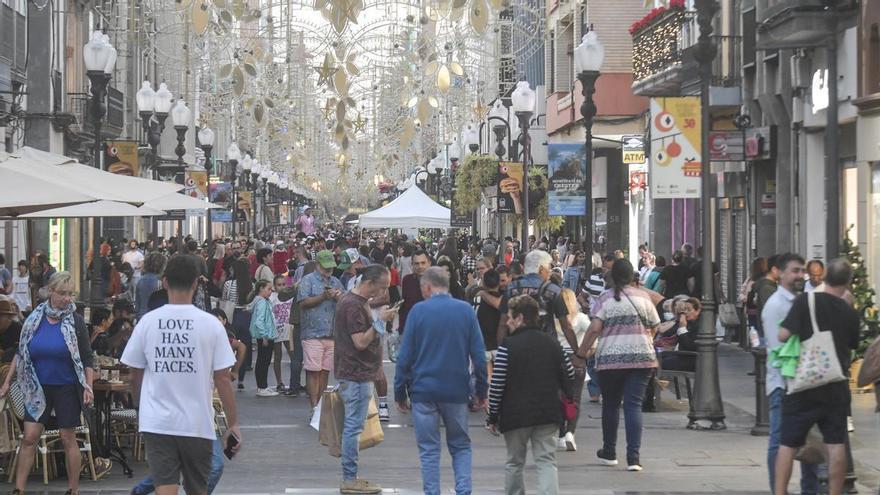
The population in Canary Islands continues to grow and does so unevenly. Not all islands bear the same population pressurefar from it. Tenerife It is, by far, the Canary Islands territory with the highest growth figures in recent years when adding 33,000 people to the register in just ten years. In 2012 the island’s residents were 898,680 and the latest official population data for January 2022 published yesterday by the Canary Islands Institute of Statistics (Istac) indicate that the figure already reaches 931,646. In that same period the Archipelago increased its population by 59,357 people, so Tenerife assumed 55% of the total growth.
Even more striking is the increase in the last year. In 2021, the year to which the latest Istac information refersfour out of five new residents they were registered on the island of Teide. In total there were 3,653, of the 4,757 new ones throughout the Canary Islands. “Tenerife is the worst off, it is suffering thoughtless growth without taking the consequences into account,” says Guillermo Morales, professor of Human Geography at the Carlos III University, who affirms that although the data from the last year show in general terms that the growth trend has slowed, these issues need to be explored in ‘longer time frames’.
Experts have warned that in just ten years the population residing in the 7,492 square kilometers of the Islands will reach 2.5 million people. Now the figure reaches 2,177,701 inhabitants, so there will be 300,000 more than at present, at a growth rate of 30,000 per year on average. A forecast that is far from the 4,757 that increased from 2020 to 2021. “The news is that we continue to grow even though this year has been slower, we must take that as something positive,” says Morales. This slowdown does not erase the fact that in the last 20 years growth in the Archipelago has been 18% according to the latest data.
problem in the drawer
The excessive increase in the population has been precisely one of the issues that has occupied the agenda politics during this legislature, more specifically during the last months of last year. The Vice President of the Government, Roman Rodriguezwent so far as to declare in August that the notable increase in the population of the Archipelago in recent decades – “disproportionate” in his own words – puts “social and economic recovery” at risk.
He even settled on the Parliament of the Canary Islands the Study Commission on the demographic challenge and population balance in the Canary Islands to analyze the data and consequently take measures. The meetings took place since the end of September and the invited experts participated and raised the situation, but since December 1, the date of the last meeting, the problem has remained in a drawer and with the elections just around the corner it seems that it is going to stay there. “The reflection was done in an epidermal way, it came to nothing and no lines of action were marked out,” laments Morales, who was one of the commission’s speakers.
Not only Tenerife has carried the growth. In the last ten years so much Lanzarote What Fuerteventura have increased their population by more than 13,000 people. They have followed the example of the capital island and are venturing towards a similar future, which scares the experts. “The excessive growth of the population cannot be used as an indicator of quality of life and economic growth, this is a real mistake,” warns the professor of Human Geography who assures that for many years there has been an erroneous idea that how much ” the more the island grows the better it will be. An issue that has even served to increase the rivalry between the capital islands.
The idea that many politicians have defended in recent months that the non-capital islands “are depopulating” is not being fulfilled. Data from recent years show that only La Palma presents a decrease of 2,000 people, but both La Gomera and El Hierro have remained stable in their figures over the last decade. Curious is the case of Gran Canariawhich despite being a capital island has data that is far removed from those of Tenerife since it has hardly changed since 2012. In ten years the round island has only gained 1,037 new residents, going from 852,225 to 853,262.
In the last year the municipality that Santa Lucía de Tirajana (Gran Canaria) grew the most, which by adding almost a thousand new residents (987) maintains a population of 74,560 people, with a growth of 11% in the last ten years. At this rate, it is gradually approaching second place in the ranking of the most populated municipalities on the island, which Telde currently occupies with 102,472 inhabitants. On the opposite side is Arrecife (Lanzarote) which in just one year lost 747 inhabitants, becoming the municipality that decreased the most in 2021, even so it remains the most populous municipality with 63,750 inhabitants.
The latest Istac data also show that The two capitals of the Islands have not yet been able to recover from the loss of population caused by the pandemic. the palms de Gran Canaria lost a total of 2,548 inhabitants in 2020 and in 2021 it only added 122, which represents 4.8%. The truth is that the capital has a negative balance behind it, since in the last ten years it has lost a total of 3,500 people. In Santa Cruz de Tenerife, 19% of the population lost during the covid year has recovered and in the last decade 1,723 residents have gained.
To understand the evolution of the data, it is important to take into account the vegetative growth, that is, the difference between the number of births and the number of deaths in a population. In the case of the Canary Islands, this is negative, there were already many more people who died (17,149) than were born (12,732) during 2021. So why did the census grow by more than 4,000 people? By what experts call “external contributions”, the number of immigrants who began to reside in the Islands from that period.
“Populations must rejuvenate and grow slowly, so we must regulate those external contributions that are the ones that are triggering the data,” says the professor of Human Geography, who assures that the key is to achieve “zero growth for a few years ». Morales advocates “subtle” measures that do not affect residents. The professor is also concerned about the pressure exerted by tourists in the territory, which is why he proposes “limiting flights following the example of regions like Malta.”
















